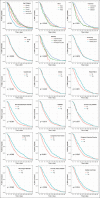Hospital length of stay among COVID-19-positive patients
- PMID: 34239994
- PMCID: PMC8259605
Hospital length of stay among COVID-19-positive patients
Abstract
Background and aim: This study aims to determine COVID-19 patient demographics and comorbidities associated with their hospital length of stay (LOS).
Methods: Design: Single-site, retrospective study. Setting: A suburban 700-bed community hospital in Newark, Delaware, USA. Patients: Patients admitted to the hospital from March 11, 2020, to August 11, 2020, with a positive COVID-19 status. We followed a time-to-event analysis approach and used Kaplan-Meir curves and log-rank tests for bivariate analyses, and an accelerated failure time model for a multivariable model of hospital LOS.
Results: Six hundred and eighty-seven patients discharged alive (mean [SD] age, 60.94 [18.10] years; 339 men [49.34%]; 307 Black/African-American [44.69%]; and 267 White [38.86%]) were included in the investigation. Bivariate analysis using Kaplan-Meir curves showed that patients' age, sex, ethnicity, insurance type, comorbidity of fluid and electrolyte disorder, hypertension, renal failure, diabetes, coagulopathy, congestive heart failure, peripheral vascular disease, neurological disorder, coronary artery disease, and cardiac arrhythmias to be significantly associated with LOS (P<0.05). In the multivariable analysis, patients' age, sex, ethnicity, number of Elixhauser comorbidities, and number of weeks since onset of the pandemic was significantly associated with LOS (P<0.05). Fluid and electrolyte disorder is the only comorbidity independently associated with LOS after adjusting for patients' age, sex, race, ethnicity, number of Elixhauser comorbidities, and weeks since onset of pandemic.
Conclusion: COVID-19 patients LOS vary based on multiple factors. Understanding these factors are crucial to improving the prediction accuracy of COVID-19 patient census in hospitals for resource planning and care delivery.
Relevance for patients: Understanding of the factors associated with LOS of the COVID-19 patients may help the care providers and the patients to better anticipate the LOS, optimize the resources and processes, and prevent protracted stays.
Keywords: COVID-19; comorbidities; length of stay.
Copyright: © Whioce Publishing Pte. Ltd.
Conflict of interest statement
The authors declare no conflicts of interest.
Figures


References
-
- Mallapaty S. Scientists Fear Coronavirus Spread in Vulnerable Nations. Nature. 2020;578:348. - PubMed
-
- Omer SB, Malani P, del Rio MC. The COVID-19 Pandemic in the US A Clinical Update. JAMA. 2020;30303:2019–20. - PubMed
-
- [Last accessed on 2020 Jun 30];WHO Director-General's Opening Remarks at the Media Briefing on COVID-19 11 March 2020. Available from: https://www.who.int/dg/speeches/detail/who-director-general-s-opening-re... .
Grants and funding
LinkOut - more resources
Full Text Sources
